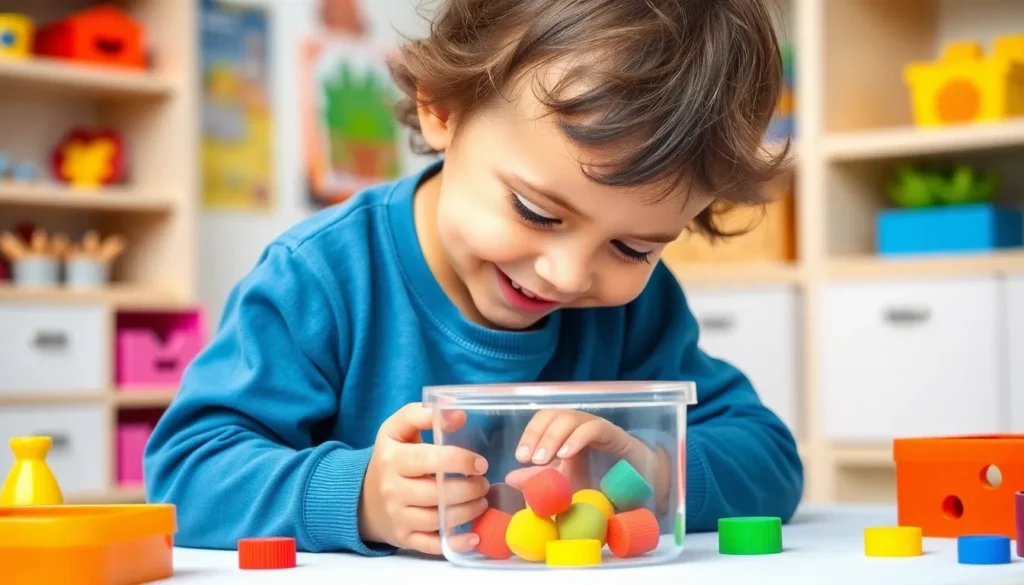In the world of child development, few concepts are as fascinating as object permanence. This magical milestone is where little ones realize that just because they can’t see something, it doesn’t mean it doesn’t exist. Think of it as the ultimate game of hide-and-seek, where babies learn that their favorite toy isn’t lost forever when it rolls under the couch. Montessori education embraces this concept, turning it into a playful adventure that fosters curiosity and independence.
Table of Contents
ToggleOverview of Montessori Object Permanence
Montessori object permanence focuses on recognizing that objects remain in existence even when out of view. This understanding plays a pivotal role in a child’s cognitive development, influencing their exploration and interaction with the world. In Montessori settings, activities designed to enhance object permanence engage infants and toddlers, inviting them to discover hidden items.
Infants engage in simple games, such as peek-a-boo, which illustrate this principle. As they observe objects appearing and disappearing, they begin to comprehend that these items still exist when not in sight. Montessori materials often include clear containers and toys that disappear and reappear in play, enhancing this learning experience.
Toddlers benefit from sensory exploration in Montessori classrooms. Simple exercises, like hiding and finding toys, reinforce the concept of permanence. Additionally, these activities promote independence, allowing children to take the initiative in their learning.
Educators observe remarkable development in problem-solving skills. When children search for hidden objects, they practice critical thinking, tests hypotheses, and develop persistence. Montessori environments encourage this exploration and create opportunities for discovery and creativity.
The significance of object permanence cannot be overstated. Understanding that the world continues to exist beyond immediate perception builds a foundation for emotional security and social interaction. By incorporating this concept into play, Montessori education nurtures both cognitive and emotional development in children.
The Importance of Object Permanence in Child Development

Object permanence plays a crucial role in child development, as it marks the understanding that objects continue to exist even when they cannot be seen. This foundational concept supports emotional security and enhances curiosity.
Understanding Object Permanence
Understanding object permanence establishes a child’s ability to recognize that items remain present despite being out of sight. Infants begin to grasp this concept around eight months of age. Prior to this, seeing an object disappear may lead to confusion. Discovering that toys remain available, even when hidden, encourages exploration. This realization can foster confidence as children engage in games, such as peek-a-boo. Seeing adults reinforce this learning through playful interactions strengthens the child’s belief in continuity.
Role in Cognitive Development
Cognitive development advances significantly with object permanence. Engaging in activities that reinforce this idea promotes critical thinking alongside problem-solving skills. Children learn to anticipate the location of hidden objects, which nurtures their memory and reasoning abilities. Incorporating these activities into Montessori environments, like searching for a toy, helps refine their exploration. Additionally, these interactions stimulate inquisitive behavior. Observing children tackle these challenges reveals their persistence and ability to work through difficulties. Hence, object permanence forms an essential building block for advanced cognitive skills.
Montessori Approach to Teaching Object Permanence
Montessori education effectively nurtures understanding of object permanence through thoughtfully curated materials and engaging activities. This approach promotes cognitive and emotional development, inviting children to explore their environment.
Materials Used in Montessori Settings
Montessori classrooms feature specific materials that enhance object permanence. Clear containers aid infants in visualizing objects that disappear from view. Toys such as cloth-covered balls serve as practical tools, allowing children to uncover hidden items. Additionally, nesting boxes empower toddlers to grasp the concept by discovering toys inside various compartments. Utilizing these materials fosters curiosity and engagement, encouraging independent exploration.
Activities to Foster Object Permanence
Interactive activities reinforce object permanence in Montessori settings. Peek-a-boo games invite children to engage in playful discovery as they learn that loved ones or toys still exist when not visible. Treasure hunts incorporate intentional hiding, allowing toddlers to search for objects, thus enhancing problem-solving skills. Simple exercises that involve placing toys under cloth encourage exploration and critical thinking. These activities not only promote object permanence but also foster emotional security, paving the way for healthy social interactions.
Benefits of Montessori Object Permanence Lessons
Montessori object permanence lessons offer several developmental benefits that support a child’s growth. Engaging in activities that promote this concept enhances cognitive skills. Children learn to understand that objects exist even when they are out of sight. This realization fosters curiosity, encouraging exploration of their environment.
Sensory experiences in Montessori classrooms play a significant role in this learning process. Using materials like clear containers or nesting boxes allows children to visualize hidden objects. Experiences such as peek-a-boo games serve not only to reinforce understanding but also to build emotional security. When a child discovers that a toy reappears, it boosts their confidence in the stability of their surroundings.
Additionally, these lessons strengthen problem-solving skills. Children develop critical thinking as they search for hidden items, enhancing their ability to strategize. It prompts them to persist, thereby nurturing resilience in the face of challenges.
Social interactions also benefit from object permanence lessons. Understanding that unseen items still exist strengthens a child’s ability to engage in cooperative play. This realization fosters healthy relationships with peers, laying the groundwork for effective communication.
Ultimately, Montessori approaches to object permanence promote both emotional and cognitive development. The combination of interactive materials and meaningful play nurtures a child’s independence and initiative. Such lessons create a foundation for future learning and exploration.
Challenges and Considerations
Montessori object permanence activities present various challenges for educators and caregivers. Understanding that children develop at different paces is critical. Some infants grasp the notion of hidden objects quickly, while others may take longer than expected. Recognizing this variability allows for tailored support during learning.
Sustaining a child’s interest poses another challenge. Activities should remain engaging to keep children motivated. Incorporating varied stimuli, such as colorful toys and different hiding spots, helps maintain their attention. Changing materials frequently encourages repeated exploration and fosters deeper understanding.
Monitoring emotional responses during object permanence activities is essential. Some children may experience frustration when they cannot locate hidden items. Providing support and encouragement during these moments helps them develop resilience and persistence. Offering a positive reinforcement approach also aids in building emotional security.
Catering to diverse learning styles is important in Montessori settings. Visual learners may benefit from clear containers and colorful objects, while auditory learners might appreciate sound effects during hide-and-seek games. Incorporating multiple sensory experiences supports all learning preferences and enriches engagement.
Assessing progress can be challenging for educators. Regular observation helps identify developmental milestones, but maintaining structured evaluations can be beneficial. Documenting children’s progress through notes or informal assessments aids in refining future activities and supports ongoing development.
Collaboration among educators and parents enhances the understanding of object permanence. Sharing insights on children’s reactions and engagement facilitates a cohesive approach to learning. Open communication fosters consistency and reinforces the concept at home and in educational settings.
Montessori object permanence is a vital component of early childhood development. By engaging children in activities that promote this concept, educators foster not only cognitive skills but also emotional security. The playful exploration of hidden objects nurtures curiosity and resilience, encouraging children to approach challenges with confidence.
As children learn that objects exist beyond their immediate sight, they develop critical thinking and problem-solving abilities that lay the groundwork for future learning. The thoughtful integration of materials and activities in Montessori settings creates an enriching environment where children can thrive. Ultimately, understanding object permanence through these methods supports a child’s holistic development, paving the way for meaningful interactions and exploration.




